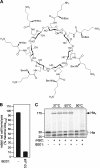Prevention and treatment of Staphylococcus aureus pneumonia with a beta-cyclodextrin derivative
- PMID: 19805564
- PMCID: PMC2798498
- DOI: 10.1128/AAC.00973-09
Prevention and treatment of Staphylococcus aureus pneumonia with a beta-cyclodextrin derivative
Abstract
Staphylococcus aureus pneumonia is a common, potentially life-threatening infection caused by this human pathogen. The only therapies available to treat S. aureus pneumonia are antibiotics, a modality that is jeopardized by the organism's remarkable ability to acquire antimicrobial resistance. S. aureus alpha-hemolysin is a pore-forming cytotoxin that is essential for the pathogenesis of pneumonia. Strains lacking this cytotoxin are avirulent in a murine model of pneumonia; likewise, vaccine-based strategies that antagonize the toxin afford protection against lethal disease. Disruption of the function of this toxin therefore provides a potent mechanism to prevent and/or treat S. aureus pneumonia. beta-Cyclodextrin derivatives are small molecules with a sevenfold symmetry that mirrors the heptameric alpha-hemolysin. These compounds block the assembled alpha-hemolysin pore, compromising toxin function. We report that a modified beta-cyclodextrin compound, IB201, prevents alpha-hemolysin-induced lysis of human alveolar epithelial cells. This protective effect does not result from the ability of the beta-cyclodextrin to impair formation of the oligomeric alpha-hemolysin on the cell surface, supporting a role for this molecule in blockade of the lytic pore. An examination of IB201 in murine S. aureus pneumonia demonstrated that administration of this compound prevents and treats disease, protecting against mortality. Consistent with the vital importance of alpha-hemolysin in pneumonia caused by methicillin-sensitive and highly virulent methicillin-resistant S. aureus strains, IB201 protects against lethal challenge with both types of isolates. These observations, coupled with a favorable safety profile of beta-cyclodextrin compounds, provide a novel strategy that may be developed to combat S. aureus pneumonia.
Figures





References
-
- Athanassa, Z., I. I. Siempos, and M. E. Falagas. 2008. Impact of methicillin resistance on mortality in Staphylococcus aureus VAP: a systematic review. Eur. Respir. J. 31:625-632. - PubMed
-
- Bubeck Wardenburg, J., T. Bae, M. Otto, F. R. DeLeo, and O. Schneewind. 2007. Poring over pores: alpha-hemolysin and Panton-Valentine leukocidin in Staphylococcus aureus pneumonia. Nat. Med. 13:1405-1406. - PubMed
Publication types
MeSH terms
Substances
Grants and funding
LinkOut - more resources
Full Text Sources
Other Literature Sources

